Racing with sound
They are such records - it seems that in everyday life no one needs them, but someone is constantly trying to put them on. This applies everywhere, take the same cars. On the one hand, the car is not a luxury, but a means of transportation ... on the other hand, this phrase is more applicable to some vegetable sedans that do not pretend to records. About cars such as the Bloodhound already can not be said - offended.
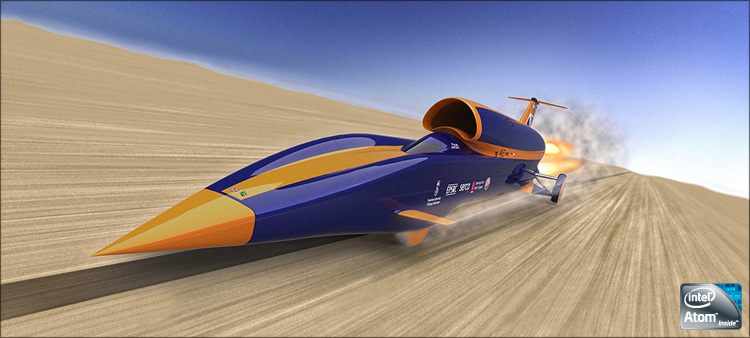
Meet the Bloodhound SSC ("Snoop") - according to the creators, the peak speed of this supersonic car should be 1050 miles per hour (1690 km / h or 1.4 speed of sound). At this speed, the supercar is going to drive in 90 seconds (fly over?) Neither more nor less, 18 kilometers. After this “short film”, the brake parachutes will stop the car with a triple overload. It is not even Formula 1 - at such crazy speeds, the car faces completely different tasks.
')
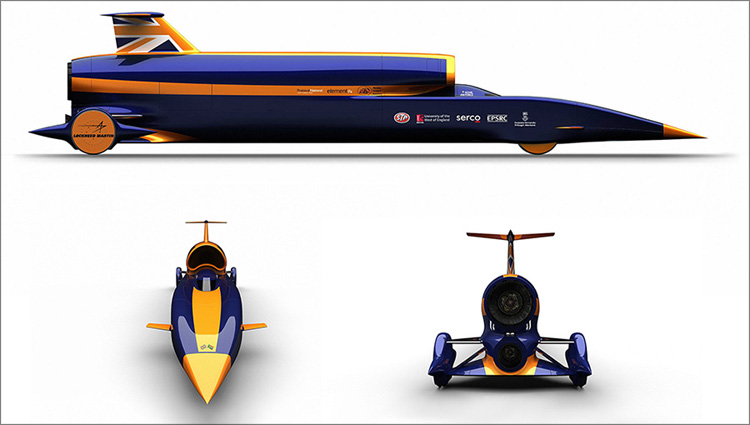
Where do these speeds come from? There is no secret - there are already three engines installed on the seven-ton thirteen-inch collar.
A hybrid rocket engine, a jet ( turbofan ) Eurojet EJ200 engine (if you believe the Internet, its power is as much as 135,000 horsepower, and the maximum torque is 90,000 Nm) and a 800-horsepower 12-cylinder V-shaped gasoline engine that pumps fuel and providing electrical and hydraulic power.

Bloodhound rocket engine test (video) in the Mojave Desert:
By the way, the Eurojet EJ200 was designed specifically for the Eurofighter Typhoon multi-role fighter, in which there are two such engines at once. But the total power in the Bloodhound is higher than that of a fighter - impressive!


Two EJ200s installed on the Eurofighter Typhoon (rear view).
How to quickly accelerate, developing 220 kilonewtons of thrust and breaking the sound barrier, and then just as quickly stop? What will happen if on a flat surface, on which the Bloodhound will go, a stone meets - at a speed of one and a half thousand kilometers per hour? How to protect the pilot from overloads, and how to save his life in case of a breakdown?
The Bloodhound SSC project ( SuperSonic Car) differs from many other commercial or private projects in that its team solves the problem of achieving record speeds in the open, and participates in several hundreds of mathematical, scientific engineering programs in the UK alone. More than three thousand educational institutions have joined the educational part of this project - from primary schools to universities. A small team of high-class engineers is working on the project - and thousands of British schoolchildren.

Dave Rowley, director of the educational project Bloodhound:
- Formally, this is an attempt to break the world speed record on land, but the primary goal of the project is to inspire young people around the world to become scientists and engineers of tomorrow. Developed countries are now experiencing a shortage of technical specialists and young scientists, but these are the very people who will help our planet to cope with pressing issues: clean energy, new types of transport, new materials, and so on. It was with the aim of popularizing science that we started this project. And he lives - in two years we, along with partner programs, have already arrived at 4,000 schools. In addition, any school on the planet can look at our website and download absolutely free educational materials on the topic. After all, look - say, the wheel is a very simple thing, but before us no one invented the wheel, which rotates at a speed of 10,000 revolutions per minute. If at such a speed a kilogram bag of sugar is put on the edge of the wheel, the bag will weigh 47 tons - incredible! It is clear that such things are extremely fascinating to schoolchildren, so teachers and students from all over the world show interest in our project.

Bloodhound wheel.
The car will be ready near the end of the year or at the beginning of the next, then it will pass low-speed test runs in the UK - we mean 250 km / h as low speeds. Then, in 2012, the car will be transported to the Hakskin plateau in South Africa, where our team will be given the main task - to overcome the mark of 1600 km / h. Hackskin is a desert plain in South Africa with a length of 19 kilometers and a width of 5 kilometers - an ideal platform for high-speed races.
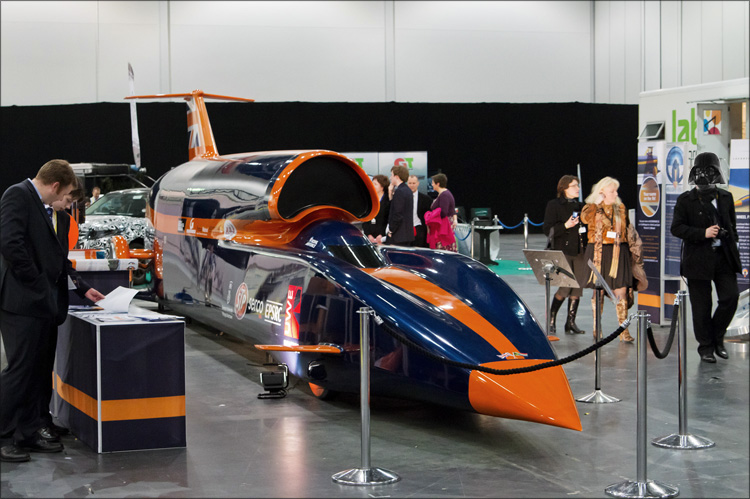

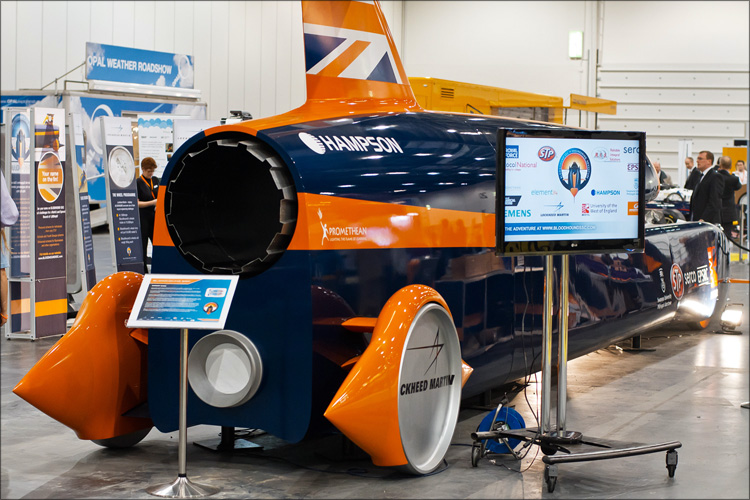
Andy Green, the pilot of the future record holder, is posing against the background of a full-size vehicle layout. About a year later, this fearless person will have to not only accelerate the car to an incredible speed, but also be able to successfully brake after acceleration. The overloads occurring at such accelerations and decelerations are quite comparable with aeronautics, so it is no coincidence that a military pilot will sit behind the wheel of a supercar.


Lieutenant Colonel of the Royal Air Force Andy Green.
By the way, a team of British engineers working on the Bloodhound SSC, in 1997, built a Thrust SSC jet car and set a world speed record of 1228 kilometers per hour. Andy Green was also driving this prototype.
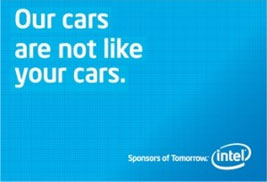 Again, guess what kind of relationship does Intel have to do with this? Yes, in principle, as usual - the corporation is doing another good thing, which gives every right to say to itself “Sponsors of tomorrow”. However, business alone does not end with sponsorship: for a car moving at supersonic speed, the most complicated and accurate calculations are needed - from the aerodynamics of the body and the physics of wheel adhesion to the dynamics of the flows inside the engines of the car. Intel is helping the project with supercomputer clusters that allow it to perform the necessary HP calculations.
Again, guess what kind of relationship does Intel have to do with this? Yes, in principle, as usual - the corporation is doing another good thing, which gives every right to say to itself “Sponsors of tomorrow”. However, business alone does not end with sponsorship: for a car moving at supersonic speed, the most complicated and accurate calculations are needed - from the aerodynamics of the body and the physics of wheel adhesion to the dynamics of the flows inside the engines of the car. Intel is helping the project with supercomputer clusters that allow it to perform the necessary HP calculations.

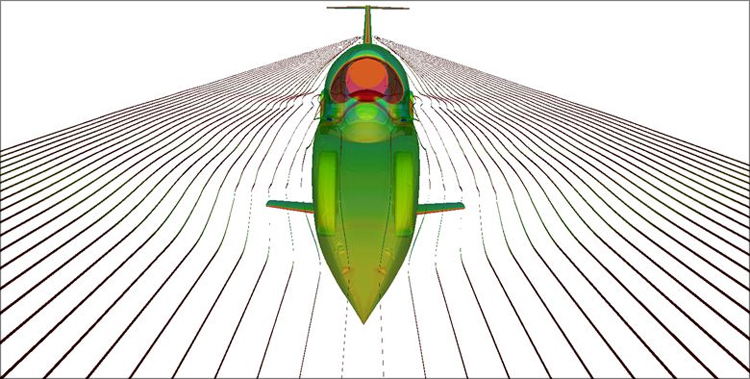

In addition, Intel plans to deploy a WiMAX network on the Hakskin plateau, where supermobile tests will be conducted; and all the telemetry on board is powered by Intel Atom processors.
Gordon Greilish, vice president of marketing and sales at Intel: “ We will inspire the younger generation to make achievements in the field of science and engineering - this will be our main victory. In the 60s, after the launch of the Apollo lunar program, the number of graduate students receiving a scientific degree doubled. We want to achieve a similar result . ”
Relatively recently, the design of the Bloodhound has undergone major changes associated with a change in the location of the engines. And it seems that now the final project has been transferred to production near Bristol in the UK - this is 60 kilometers from the Intel office in Swindon. About a year later, a new world speed record should be set, a third higher than the old one - perhaps it will look something like this:

 Interesting facts about the Bloodhound SSC | Specifications
Interesting facts about the Bloodhound SSC | Specifications
Successes!

Meet the Bloodhound SSC ("Snoop") - according to the creators, the peak speed of this supersonic car should be 1050 miles per hour (1690 km / h or 1.4 speed of sound). At this speed, the supercar is going to drive in 90 seconds (fly over?) Neither more nor less, 18 kilometers. After this “short film”, the brake parachutes will stop the car with a triple overload. It is not even Formula 1 - at such crazy speeds, the car faces completely different tasks.
')

Where do these speeds come from? There is no secret - there are already three engines installed on the seven-ton thirteen-inch collar.
A hybrid rocket engine, a jet ( turbofan ) Eurojet EJ200 engine (if you believe the Internet, its power is as much as 135,000 horsepower, and the maximum torque is 90,000 Nm) and a 800-horsepower 12-cylinder V-shaped gasoline engine that pumps fuel and providing electrical and hydraulic power.

Bloodhound rocket engine test (video) in the Mojave Desert:
By the way, the Eurojet EJ200 was designed specifically for the Eurofighter Typhoon multi-role fighter, in which there are two such engines at once. But the total power in the Bloodhound is higher than that of a fighter - impressive!


Two EJ200s installed on the Eurofighter Typhoon (rear view).
| The car got its name “Bloodhound” in honor of the Bristol Bloodhound 2 air defense missile, which was in service with Great Britain in 1960–1991. The length of the car is 12.8 m, width - 6.4 m, and the mass with fuel - 6422 kg. It is expected that the car will reach the maximum speed in 40 seconds, passing approximately half of the way - it will brake the rest of the distance. The frequency of rotation of the 900-mm wheels at a maximum speed of more than 10 thousand revolutions per minute. |
The Bloodhound SSC project ( SuperSonic Car) differs from many other commercial or private projects in that its team solves the problem of achieving record speeds in the open, and participates in several hundreds of mathematical, scientific engineering programs in the UK alone. More than three thousand educational institutions have joined the educational part of this project - from primary schools to universities. A small team of high-class engineers is working on the project - and thousands of British schoolchildren.

Dave Rowley, director of the educational project Bloodhound:
- Formally, this is an attempt to break the world speed record on land, but the primary goal of the project is to inspire young people around the world to become scientists and engineers of tomorrow. Developed countries are now experiencing a shortage of technical specialists and young scientists, but these are the very people who will help our planet to cope with pressing issues: clean energy, new types of transport, new materials, and so on. It was with the aim of popularizing science that we started this project. And he lives - in two years we, along with partner programs, have already arrived at 4,000 schools. In addition, any school on the planet can look at our website and download absolutely free educational materials on the topic. After all, look - say, the wheel is a very simple thing, but before us no one invented the wheel, which rotates at a speed of 10,000 revolutions per minute. If at such a speed a kilogram bag of sugar is put on the edge of the wheel, the bag will weigh 47 tons - incredible! It is clear that such things are extremely fascinating to schoolchildren, so teachers and students from all over the world show interest in our project.

Bloodhound wheel.
The car will be ready near the end of the year or at the beginning of the next, then it will pass low-speed test runs in the UK - we mean 250 km / h as low speeds. Then, in 2012, the car will be transported to the Hakskin plateau in South Africa, where our team will be given the main task - to overcome the mark of 1600 km / h. Hackskin is a desert plain in South Africa with a length of 19 kilometers and a width of 5 kilometers - an ideal platform for high-speed races.



Andy Green, the pilot of the future record holder, is posing against the background of a full-size vehicle layout. About a year later, this fearless person will have to not only accelerate the car to an incredible speed, but also be able to successfully brake after acceleration. The overloads occurring at such accelerations and decelerations are quite comparable with aeronautics, so it is no coincidence that a military pilot will sit behind the wheel of a supercar.


Lieutenant Colonel of the Royal Air Force Andy Green.
By the way, a team of British engineers working on the Bloodhound SSC, in 1997, built a Thrust SSC jet car and set a world speed record of 1228 kilometers per hour. Andy Green was also driving this prototype.
 Again, guess what kind of relationship does Intel have to do with this? Yes, in principle, as usual - the corporation is doing another good thing, which gives every right to say to itself “Sponsors of tomorrow”. However, business alone does not end with sponsorship: for a car moving at supersonic speed, the most complicated and accurate calculations are needed - from the aerodynamics of the body and the physics of wheel adhesion to the dynamics of the flows inside the engines of the car. Intel is helping the project with supercomputer clusters that allow it to perform the necessary HP calculations.
Again, guess what kind of relationship does Intel have to do with this? Yes, in principle, as usual - the corporation is doing another good thing, which gives every right to say to itself “Sponsors of tomorrow”. However, business alone does not end with sponsorship: for a car moving at supersonic speed, the most complicated and accurate calculations are needed - from the aerodynamics of the body and the physics of wheel adhesion to the dynamics of the flows inside the engines of the car. Intel is helping the project with supercomputer clusters that allow it to perform the necessary HP calculations.


In addition, Intel plans to deploy a WiMAX network on the Hakskin plateau, where supermobile tests will be conducted; and all the telemetry on board is powered by Intel Atom processors.
Gordon Greilish, vice president of marketing and sales at Intel: “ We will inspire the younger generation to make achievements in the field of science and engineering - this will be our main victory. In the 60s, after the launch of the Apollo lunar program, the number of graduate students receiving a scientific degree doubled. We want to achieve a similar result . ”
Relatively recently, the design of the Bloodhound has undergone major changes associated with a change in the location of the engines. And it seems that now the final project has been transferred to production near Bristol in the UK - this is 60 kilometers from the Intel office in Swindon. About a year later, a new world speed record should be set, a third higher than the old one - perhaps it will look something like this:

 Interesting facts about the Bloodhound SSC | Specifications
Interesting facts about the Bloodhound SSC | SpecificationsSuccesses!
Source: https://habr.com/ru/post/116530/
All Articles